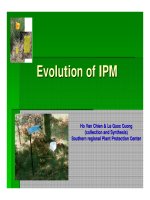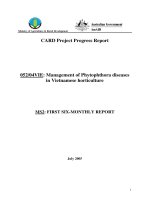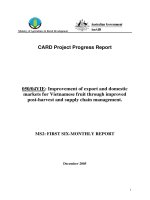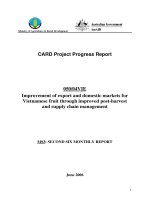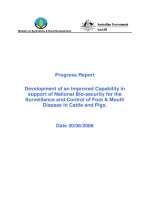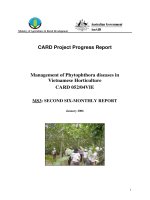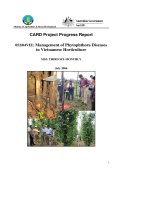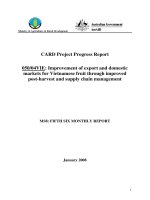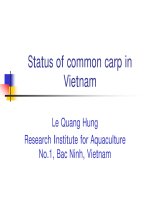Báo cáo nghiên cứu khoa học " Development of an Improved Capability in support of National Bio-security for the Surveillance and Control of Foot & Mouth Disease in Cattle and Pigs " ppt
Bạn đang xem bản rút gọn của tài liệu. Xem và tải ngay bản đầy đủ của tài liệu tại đây (209.17 KB, 34 trang )
Ministry of Agriculture & Rural Development
Completion Report
1
Development of an Improved Capability in
support of National Bio-security for the
Surveillance and Control of Foot & Mouth
Disease in Cattle and Pigs.
Chris Morrissy
1
Submitted July 2010
Table of Contents
1. Institute Information ____________________________________________ 1
2. Project Abstract _______________________________________________ 2
3. Executive Summary ____________________________________________ 2
4. Introduction & Background ______________________________________ 4
4.1 Objectives of the project ___________________________________________ 4
4.2 Implementation Approach and Strategy ______________________________ 4
5. Progress to Date _______________________________________________ 5
5.1
Implementation Highlights
_______________________________________ 5
5.2 Smallholder Benefits ________________________________________ 7
5.3 Capacity Building ___________________________________________ 7
5.4 Publicity __________________________________________________ 8
5.5 Project Management ________________________________________ 8
6. Report on Cross-Cutting Issues __________________________________ 9
6.1 Environment _______________________________________________ 9
6.2 Gender and Social Issues ____________________________________ 9
7. Implementation & Sustainability Issues ____________________________ 9
7.1 Issues and Constraints ______________________________________ 9
7.2 Options ___________________________________________________ 9
7.3 Sustainability _____________________________________________ 10
8. Next Critical Steps ____________________________________________ 10
9. Conclusions__________________________________________________ 11
9.1 Acknowledgements ______________________________________________ 12
10. Statuatory Declaration _________________________________________ 14
11. Project progress against proposed objectives, outputs, activities and
inputs ____ ___________________________________________________16
1
1. Institute Information
Project Name
CARD FMD [072/04VIE]
Vietnamese Institution
Regional Animal Health Office (RAHO-6)
Ho Chi Minh City
South Vietnam
Vietnamese Project Team Leader
Dr Dong Manh Hoa
Australian Organisation
Australian Animal Health Laboratory
[AAHL] Private Bag 24
Geelong, VIC 3220
Australia
Australian Personnel
Mr Chris Morrissy
Date commenced
01/06/2005
Completion date (original)
01/06/2008
Completion date (revised)
Reporting period
Project Completion Report
Contact Officer(s)
In Australia: Team Leader
Name:
Mr Chris Morrissy
Telephone:
+61 3 5227 5000
Position:
Supervisor Mammalian Virology
Fax:
+61 3 5227 5555
Organisation
Australian Animal Health
Laboratory [AAHL]
Private Bag 24
Geelong, VIC 3220,
Australia
Email:
In Australia: Administrative Contact
Name:
Mr Christopher Morrissy
Telephone:
+61 3 5227 5434
Position:
Patents Contracts Officer
Fax:
+61 3 5227 5555
Organisation
Australian Animal Health
Laboratory [AAHL]
Private Bag 24
Geelong, VIC 3220
Australia
Email:
christopher.morrissy@
csiro.au
In Vietnam
Name:
Dr Dong Manh Hoa
Telephone:
+ 84 8 8568220
Position:
Director
Fax:
+ 84 8 8569050
Organisation
Regional Animal Health Office
(RAHO-6)
Ho Chi Minh City
South Vietnam
Email:
2
2. Project Abstract
The aims of this project were to develop capacity for FMD diagnosis, surveillance
and control at both a laboratory and field level within the wider animal health network
in Vietnam. Improved diagnostic capacity will facilitate early detection and identification
of FMD enabling better disease control. Specifically, successful capacity development
at regional laboratories will enable quality assured laboratory capability for FMDV
diagnosis and serology. This will be applied to the investigation of FMDV serotypes
currently in circulation, vaccination coverage/response and the elucidation of on-
going suspected FMD vaccine failures in Vietnam. In addition, the successful
establishment of an effective laboratory network for the diagnosis and control of
FMD will provide a greater understanding of FMD epidemiology and will facilitate the
coordination and implementation of effective vaccination control strategies via the
wider animal health network in Vietnam.
3. Executive Summary
On completion, this project has realised all laboratory-based objectives at a national
level. However, due to the lack of epidemiology support and the diversion of DAH
resources to deal with outbreaks of AI and PRRSV, field-dependent objectives were
only achieved to a varying extent throughout Vietnam as a whole. Nevertheless all
project objectives were fully realised and with great effect in southern Vietnam.
Despite considerable achievements on a regional basis, this project clearly
demonstrates the consequences of not having a fully integrated FMD diagnostic and
surveillance network at a national level. In relation to FMD capacity development
and sustainability, one of the primary aims of this project was to “highlight the
importance of having an integrated laboratory network to identify what is happening
in the field and how to prevent and control outbreaks”. This project on a national
scale was undoubtedly ambitious. Indeed this was the intention and in this respect
the project has been highly effective. For example, the considerable success
achieved in southern Vietnam has highlighted RAHO-6 as an exemplar to DAH. In
addition, the success achieved by RAHO-6 will act as an impetus to other regional
offices in relation to the requirement for closer integration and clear, effective, two-
way communication between laboratory and field-based personnel.
During the course of the project there was a clear improvement and advances in
both laboratory and field-based activities for the diagnosis and control of FMD. The
AAHL Scientific Coordinator has mentored and liaised extensively with four
diagnostic laboratories; RAHO-6 [HCMC]; NCVD [Hanoi]; RAHO-7 [Can Tho];
RAHO-4 [Da Nang] and one research laboratory, NAVETCO [HCMC]. As a result of
successful capacity development and technology transfer from AAHL the RAHO-6
and NCVD laboratories now possess comprehensive, quality assured capabilities to
diagnose FMD and perform sero-surveillance. In addition, both laboratories are
capable of performing FMD virus isolation, virus neutralisation, ELISAs, PCR and
sequencing/genotyping for the characterisation of FMD field isolates. All FMD
laboratory diagnostic capabilities have been subject to internal quality assurance
following on-site appraisal by the AAHL Scientific Coordinator using reference
reagents supplied by AAHL and also external quality assurance using PT Panels
from both AAHL and the FMD Regional Reference Laboratory in Thailand as
detailed in earlier Milestone reports. This has resulted in the recognition of both
RAHO-6 and NCVD as FMD Reference Laboratories in Vietnam.
3
In addition, quality assured FMD diagnostic capability in the form of the AAHL FMD
Ag ELISA [for the detection of virus] and both the AAHL FMD C-ELISA and LP-
ELISA [for post-vaccination surveillance] have been successfully established at both
RAHO-4, RAHO-7 and NAVETCO.
Following the establishment of comprehensive FMD diagnostic, virus isolation and
serotyping capability at RAHO-6 tests have been implemented with both zeal and
determination and of particular significance, with a long-term strategic vision. For
example, the isolation and propagation of FMD serotypes in cell culture has been
used by RAHO-6 to produce their own FMD antigens for in-house ELISA use and
are distributing this antigen for use in other regional laboratories in Vietnam. In
addition, ongoing sero-surveillance, vaccine efficacy monitoring and the serotyping
of FMD field isolates has facilitated the evidence-based selection of the most
appropriate FMD vaccine serotype composition and the identification of disease
incursions from adjacent countries.
As detailed in earlier Milestone Reports, central to the achievement of project
objectives in regions such as southern Vietnam was the close integration of
laboratory and field-based activities. Overall, there was a significant improvement in
the amount of data and quality of field specimens submitted to the laboratories over
each surveillance round. This reflected a greater appreciation of the importance of
high quality field data and clinical specimens for FMD surveillance and control by
regional laboratories. The realisation of project objectives in regions such as
southern Vietnam was greatly facilitated by the leadership, focus and vision of the
main collaborating laboratory / office, RAHO-6. In particular, the establishment and
support of an epidemiological unit at RAHO-6 as a result of this project has greatly
assisted in the training of epidemiologists and field veterinarians in FMD sero-
surveillance, outbreak control and disease investigation including vaccine failure.
During the course of this project, this closer integration, collaboration and
communication between RAHO-6 laboratory / office and field personnel in southern
Vietnam has facilitated the acquisition of the necessary high quality field data and
clinical specimens. This highly effective two-way integration has resulted in an every
decreasing incidence of FMD outbreaks in southern Vietnam with only one isolated
outbreak being detected in the 2009-2010 reporting period. This significant
achievement has been noted by DAH, attests to the effectiveness of the project
implementation approach, and highlights the successful RAHO-6 “lab-to-field” and
“field-to-lab” integration as an exemplar to other regional laboratories / offices.
Sero-surveillance and epidemiological studies have enabled the acquisition of
important data in relation to vaccine coverage, the serotyping of FMD field isolates
and the prevalence of FMD infection in Vietnam. This data has enabled driven
science-based changes in vaccine recommendations to be made with great effect in
the field. This project has not only been of benefit to Vietnam but has also lead to a
greater knowledge and understanding of circulating FMDV genotypes and the
benefits of sero-surveillance for the whole region. In acknowledgement of the
significance of this work, project participants have been invited to a number of
regional [SEAFMD LabNet 2010; SEAFMD LMWG 2008] and international meetings
[EU-FMD; OIE Subcommittee 2010] to present Vietnam’s highly effective
implementation strategy for the control of FMD. Of particular significance, it should
be noted that as a result of this project Vietnam is recognised internationally as
model example to other counties in the region in relation to the successful
implementation of FMD diagnostic tests, sero-surveillance, outbreak investigations
and disease control.
4
4. Introduction & Background
4.1 Objectives of the project:
1. To establish an effective laboratory network for the diagnosis and control of
FMD by the provision of resources and training of staff in required methods
and quality assurance.
2. To provide accurate data to explain failure of vaccination to control FMDV
and to develop new effective vaccine application strategies.
Completing these objectives will improve the diagnostic capability of veterinary
laboratories in Vietnam and achieve training of DAH veterinarians in disease
investigation and control. This will strengthen both the role and the profile of DAH
which will play a vital role in making Vietnam more economically competitive. In
addition, improved animal health will lead to an increase in rural productivity though
increased animal production. Healthy animals will enable small farmers to be more
competitive in the local market and the control of FMD will reduce poor farmers’
vulnerability to FMD outbreaks and result in a more stable income stream.
Establishing a diagnostic network which extends from the North to South Vietnam,
from the laboratory to the farm level, reinforced by training and education, will give
Vietnam a more integrated animal health network and greatly facilitate disease
control. This will directly increase the competitiveness and productivity of the
national agricultural system which includes the major areas of concern including the
Mekong Delta and the Central Coast.
4.2 Implementation Approach and Strategy
The approach for technology transfer is well established at AAHL and has been
successfully applied in previous projects in Vietnam, Thailand and Indonesia. The
project approach used was also thought to be the most appropriate for developing
an understanding of FMD epidemiology in Vietnam. All studies were designed in
conjunction with DAH with the aim to provide the critical information in relation to
current FMD status in Vietnam and the effectiveness of FMD vaccine usage in the
field. The diagnostic technologies that will be used in this approach are the standard
OIE diagnostic tests in use throughout the world to study, control and eradicate
FMD.
AAHL has extensive experience in FMD technology transfer and capacity
development including the implementation of field surveys for the measurement of
the prevalence of antibodies against FMD such as earlier ACIAR projects in Laos
and Thailand.
5
5. Progress to Date
5.1 Implementation Highlights [Upon Project Completion]
The main achievements of the project were:
• Successful capacity development for the diagnosis, surveillance and
control of FMD in Vietnam. Specifically, the following quality assured
FMD diagnostics were established in the collaborating laboratories:
RAHO6 and NCVD laboratories have established comprehensive cell
culture, virus isolation, virus neutralisation test, ELISA, PCR,
sequencing/genotyping capability
• It should be noted that both RAHO-6 and NCVD have achieved
FMD Reference Laboratory status in Vietnam
RAHO4, RAHO7 and NAVETCO laboratories also have the capability
for FMD diagnosis and serology by ELISA for post-vaccination
surveillance
All laboratories in the project are able to utilise the AAHL LP-ELISA, C-
ELISA and 3ABC ELISA to establish the sero-prevalence of FMD in
herds and vaccine coverage post-vaccination
All laboratories have implemented an in-house Quality Assurance
system to monitor the accuracy of test results
• The project has both driven and inspired an increase in collaboration
between the Vietnamese laboratories and helped nurture a more
integrated animal health laboratory network
This will be essential not only for the control of FMD and has since been
applied to other animal diseases such as resent PRRSV outbreaks in
Vietnam
• Improvement in the quality and number of samples submitted to the
laboratory for serotyping by ELISA.
The closer integration of laboratory and field-based personnel, e.g. as
achieved by RAHO-6, combined with improved diagnostic capacity and
capability throughout Vietnam has led to the serotyping of a greater
number of clinical specimens at both RAHO-6 and NCVD
In addition, the significant improvement in sample collection and
specimen submission has allowed virus isolation from field samples.
This was not been possible prior to the initiation of this project and of
particular significance has enabled genotyping of FMDV field isolates
This has enabled DAH to achieve a greater understanding of the
serotypes of FMD viruses circulating in Vietnam and provided essential
baseline data in relation to the future control of FMD throughout Vietnam
6
• Genotyping and analysis of approx. 100 Vietnamese FMD field isolates
collected from 2006 onwards
Genotyping data was detailed in Appendix 1 of the earlier Milestone 3
report
Sequence data was sent to WRL for additional confirmation and
comparison to other FMD isolates
This information was shared with SEAFMD as part of the regional
project to control FMD
Genotyping has elucidated the reason underlying vaccine failures in the
field and has successfully established capability in Vietnam to determine
the source of a FMD outbreak and to make evidence-based decisions in
relation to whether the current vaccine serotype compositions are
appropriate.
Genotyping, combined with the ability to carry out VNT for determining
antigenic variation of field isolates, has enabled Vietnamese laboratories
to investigate future vaccine failures
Of particular significance, this has already resulted in the elucidation of
vaccine failures in the field as a result of inappropriate vaccine
composition usage as detailed in the earlier Milestone 8 Report
• Standard forms and protocols for collection of field data and trained field
veterinarians in how to carry out disease investigation for control of
disease and vaccine failure
• A model approach for a program to control FMD with a strong laboratory
and field component
• Throughout the project AAHL consultants have mentored and liaised
extensively with collaborating laboratories to achieve the following:
Established a comprehensive portfolio of internally and externally quality
assured FMD diagnostic techniques at the newly established FMD
Reference Laboratories at RAHO-6 and NCVD and related quality
assured FMD ELISAs at all participating laboratories
Appraised quality assurance records and data collection under in-house
QA systems to ensure test records were being maintained and results
were interpreted correctly
Established and appraised cell culture and virus isolation capability for
growth of FMD isolates from the field which has enabled further
genotyping of FMD field isolates
Validated an in-house ELISA using FMD antigen produced at RAHO-6
using Vietnam isolates. The production and supply of this antigen to
other laboratories facilitates future sustainability
Established and appraised molecular techniques to ensure best practice
workflow for FMD diagnostic PCR under local conditions
Provided advice on the design and format of sample submission, data
collection forms and outbreak investigation surveys to facilitate the
acquisition of high quality field data and specimen submissions
Analysed and interpreted field and laboratory data
7
Supplied consumables, reference IQC reagents and EQA PT reagents
to confirm successful establishment of quality assured FMD diagnostic
tests
On-going appraisal of laboratory quality assurance procedures and
advice in relation to individual laboratory quality assurance manuals and
SOPs
5.2 Smallholder Benefits
All pig and cattle and producers are potential beneficiaries. To date, revised vaccine
recommendations, made based on the serotyping and genotyping of Vietnamese
FMDV field isolates have already resulted in improved vaccine strategies in the field
and during the course of this project has facilitated a significant reduction in the
incidence of FMD outbreaks in Vietnam. On-going FMD surveillance, serotyping
and genotyping of field isolates will continue to improve the effectiveness of tailored
vaccination strategies in the field in Vietnam. This will continue to be of financial
benefit to small farmers through reduced losses due disease in their cattle and pigs.
DAH personnel, district veterinarians and farmers have gained improved knowledge
and appreciation with regard to the selection of the most appropriate vaccine
serotype[s] composition which will improve the efficacy of vaccination and the
realisation of long-term goals in relation to the control of FMD in Vietnam.
5.3 Capacity Building
This project has achieved the successful establishment of quality assured FMD
diagnostic capability throughout Vietnam. Of particular significance, both RAHO-6
and NCVD have established comprehensive quality assured FMD diagnostic
capabilities and have subsequently attained FMD Reference Laboratory status in
Vietnam. In addition, RAHO6 and NCDV have also established virus isolation, cell
culture, virus neutralisation and virus genotyping capabilities which will facilitate the
on-going characterisation of FMDV field isolates. In relation to capacity
development at a national level, all collaborating laboratories have established FMD
ELISA diagnostic capabilities for the diagnosis of FMD and for routine sero-
surveillance.
In relation to the achievement of long-term objectives, capacity development with
regard to the training and education of field veterinarians in sample and data
collection was of particular importance. It was readily apparent that an integrated
“lab-to-field” and “field-to-lab” approach is a central logistical consideration in relation
to FMD control in the field. The effectiveness of this approach was exemplified by
the considerable successes in southern Vietnam, where greater two-way “lab-to-
field” integration and cohesion resulted in an increase in both the quality and number
of samples collected and submitted to the laboratory which enabled the highly
effective control of FMD in the field.
This project has established a model for FMD control with the success achieved in
southern Vietnam representing an exemplar to other regional laboratories and to the
SEA region as a whole. Nevertheless, of particular significance, this project has also
highlighted some inherent shortcomings at a national level in relation to the logistics
associated with the implementation of the National FMD Surveillance Program in
Vietnam.
8
5.4 Publicity
This CARD AusAID project has received highly favourable publicity in Vietnam,
Australia and internationally and recognition of the achievements made in relation to
the understanding and control of FMD in Vietnam. FMD is a disease of importance
in Vietnam and of strategic significance not only to Australia and neighbouring
countries in SEA but also worldwide. As a result of this CARD AusAID and earlier
ACIAR projects in the region the highly effective AAHL FMD capacity development
and implementation approach is regarded at the “Gold Standard” in relation to the
investigation and control of FMD is SEA. The project has been publicised through a
press releases in Australia and articles in newsletters including the SEAFMD
newsletter and on the internet. The results from the project have been presented at:
o OIE/SEAFMD meetings 2008; 2010
o EU FMD 2008
o WAVLD 2007; 2009
o Lower and Upper Mekong Regional Working Group meetings.
5.5 Project Management
AAHL was generally able to keep the project on target and was able to support
requests from the Vietnamese partners. However, there was a delay in the last
round of sample collection primarily due to interrupted vaccine supply. Of particular
significance, the acquisition of suitable clinical specimens from the north and centre
of Vietnam was hampered by the unforeseen reprioritisation of DAH personnel to
deal with outbreaks of AI and PRRSV.
Nevertheless, the management and implementation of highly effective measures for
the diagnosis and control of FMD was particularly successful in the south of
Vietnam. Overall, trainees were supplied in a timely manner by DAH and both the
coordination and implementation of field work improved throughout the course of the
project with all but one province participating. The efforts made by the AAHL
Scientific Coordinator in relation to mentoring and nurturing of the enthusiastic and
talented personnel in the regional laboratories have led to much greater integration,
cohesion and determination.
The lead Vietnamese collaborating laboratory [RAHO-6] has been a driving force
behind the greater “lab-to-field” and “field-to-lab” integration and the subsequent
successful implementation of highly effective FMD control in the field in Vietnam. In
addition, as an FMD Reference Laboratory, RAHO-6 continues to conduct FMD
training activities and to both support and supply diagnostic reagents to other
regional laboratories.
9
6. Report on Cross-Cutting Issues
6.1 Environment
No adverse environmental impacts associated with project activities were identified.
In a wider context, it is anticipated that pig and cattle farming will become more
efficient through a reduction in animal deaths and FMD disease outbreaks with
resultant environmental benefit through more efficient utilization of resources.
6.2 Gender and Social Issues
The establishment and successful implementation of new FMD diagnostic tests has
improved the ability of regional and provincial diagnostic laboratories to quickly and
accurately assess FMD outbreaks, thereby enabling rapid and appropriate control
measures to be implemented in the field. Significant benefits have already been
observed and will continue to accrue during subsequent rounds of sero-surveillance,
field virus characterisation with resultant evidence-based selection and vaccine
intervention. The beneficiaries of this project will be both large and small farms and
particularly smallholder farmers whose animals and incomes will be protected by
better disease diagnosis, management and control. From a gender perspective,
since women at the village level are the primary animal handlers and managers they
will be major beneficiaries.
7. Implementation & Sustainability Issues
7.1 Issues and Constraints
Throughout the course of this project field staff and DAH personnel were regularly
diverted to investigate and control AI & PRRS outbreaks in Vietnam. This
significantly reduced the DAH and field staff time available for the project, led to
incomplete data / sample acquisition and resulted in limited sero-surveillance in
Northern and Central provinces.
Initial project implementation in the field highlighted the need for further training of
field veterinarians in disease investigation techniques with a focus on sample and
data collection. Although this was achieved in some areas, with sample and data
collection improving throughout the course of the project, in some regions this issue
still remains problematic and an impediment to the successful implementation of
project objectives at a national level. As a result of this project, there is a much
greater appreciation and acknowledgement by all collaborators of the need for large
scale training of field veterinarians and concomitant resources to ensure better
sample collection, laboratory submission and data acquisition to facilitate the control
of FMD in Vietnam. Training of DAH staff in epidemiology and data analysis was
also identified as an area that will require future investment. This could be achieved
though greater synergy between the various aid agencies operating in Vietnam.
7.2 Options
The government of Vietnam is considering increasing the support to DAH, has
increased funding for AI diagnosis and will probably do the same for FMD diagnosis.
In this respect, greater integration and synergy are key considerations with the
increased funding for AI supplying new equipment which can be applied to all
disease diagnosis activities including FMD. In addition, it would be prudent that
investment should be targeted at training and equipping field veterinarians and
10
related personnel with general disease investigation skills rather than focussing
solely on HPAI.
7.3 Sustainability
The DAH laboratories appear to be well supported by the central government. The
DAH laboratories are also receiving increased support from overseas funding
agencies as part of the AI campaign to improve laboratory facilities.
RAHO-6 has gained confidence as an FMD Reference Laboratory and has
implemented highly successful technology transfer and training activities to other
regional laboratories. Of particular significance, RAHO-6 has acted as an exemplar
to other regional laboratories, and the wider animal health network in Vietnam, with
regard to the successful design and implementation of highly effective FMD
diagnostic, surveillance and control strategies in the field.
DAH scientific staff were quick to understand new information, energetic in its
implementation and demonstrated an obvious desire to do their jobs well. This was
particularly evident by the drive, determination and professionalism exhibited by the
RAHO-6 staff in relation to the successful achievement of project objectives.
This project followed the tried and tested AAHL approach for successful technology
transfer and capacity development. This approach began with demonstration and
training at AAHL followed by the supply of reference reagents and procedures for
implementation by the trainees at their own initiative in the recipient laboratory. This
was subsequently consolidated following a series of ongoing consultancy visits by
the AAHL Scientific Coordinator to the recipient laboratory for on-site support,
encouragement, appraisal and “trouble shooting”.
Resultant quality assured FMD capacity development, in particular at RAHO-6 and
NCVD, has proven to be highly sustainable with both laboratories having achieved
FMD Reference Laboratory status in Vietnam. For example, the fact that RAHO-6 is
producing reference antigen for in-house use and also supplying this to other
regional laboratories clearly attests to current capacity, capabilities and future
sustainability. In addition, RAHO-6 have, at their own initiative and unassisted by
AAHL, conducted FMD training courses and technology transfer to other labs in
Vietnam. This project is just one of a series of highly successful AusAID and ACIAR
funded projects that have linked AAHL to both Vietnamese and SEA laboratories, all
of which have been proven to be sustainable.
8. Next Critical Steps
Project objectives were achieved throughout Vietnam and with considerable success
in southern Vietnam. However, throughout the implementation of this project one of
the key lessons learnt was in relation to the importance of complete and accurate
field information and timely laboratory submission of appropriate clinical specimens.
Whereas laboratory scientists were accustomed to accurate recording of results, in
the field the recording of information such as comprehensive vaccination records
and related data was not common place.
Through the implementation of a series of data collection and field surveillance
forms, data collection, management and laboratory submissions have improved
dramatically throughout the course of this project. Nevertheless, it was clearly
evident that continued training and support of field veterinarians and the greater
integration and coordination of “lab-to-field” and “field-to-lab” activities will be critical
for the successful implementation of FMD control measures at a national level.
11
9. Conclusions
This project has realised objectives in relation to FMD diagnosis, surveillance and
control via successful capacity development and subsequent implementation of
quality assured FMD diagnostics at both a regional and a national level in Vietnam.
Specifically, both the RAHO-6 and NCVD laboratories have attained FMD Reference
Laboratory status and possess comprehensive quality assured FMD diagnostic
capabilities and the ability to isolate, serotype and genotype FMDV field isolates. On
a national level, RAHO-4, RAHO-7 and NAVETCO also have the capability to
perform ELISAs for the detection of FMD antigen and antibodies, further
consolidating FMD diagnostic capabilities within the wider animal health network in
Vietnam. This project has significantly aided DAH gain a greater understanding and
appreciation of the logistic requirements and field skills that will be required for the
effective control of FMD in Vietnam. In addition, this project has also generated
important baseline data in relation to vaccination coverage in the field and the
prevalence of FMD serotypes in circulation in Vietnam.
In relation to FMD surveillance, resultant capabilities for serology by ELISA has
enabled post-vaccination surveillance and has facilitated the investigation of the
efficacy of vaccine coverage and ongoing surveillance which has demonstrated
continual improvement in relation to FMD vaccine coverage in the field. This is of
particular significance insofar as FMD vaccine is expensive and represents the main
cost component associated with FMD control in Vietnam. This project has
highlighted the requirement for ongoing post-vaccination sero-surveillance to
achieve a greater return on investment and ensure cost effective implementation of
FMD vaccination in the field in Vietnam.
Of particular significance, in relation to FMD control, the subsequent serotyping and
genotyping of FMDV field isolates has enabled evidence-based assessment of the
prevalence and risks associated with individual FMD serotypes in specific regions.
This has resulted in highly informed science-based recommendations being made to
Department of Animal Health (DAH), field veterinarians and farmers with regard to
the selection of the most appropriate FMD vaccine serotype formulations to be used
in the field. The effectiveness of this approach was clearly evident from the fact that
in southern Vietnam the incidence of FMD outbreaks has fallen continuously during
the course of the project with only one isolated outbreak being reported in the 2009-
2010 reporting period.
Throughout the course of this project both the quality of field data and the integrity of
specimen submissions showed continuous improvement. However it was widely
recognised at an early stage that the critical component for FMD control was the
requirement for closer integration, support and communication between laboratory
and field personnel. In areas where this critical issue was addressed, the
effectiveness of the implementation strategy adopted was readily apparent. For
example, the implementation strategy at RAHO-6 where successful capability
development and quality assurance in the laboratory was the driving force behind
more effective training and education of field veterinarians realised project objectives
and resulted in effective FMD management in the field. Specifically, the two-way
communication, support and collaboration between the RAHO-6 laboratory / office
and field veterinarians facilitated highly effective disease diagnosis, surveillance and
control in southern Vietnam. The RAHO-6 epidemiology section have been highly
proactive in engaging and training both provincial veterinarians and field staff and it
is considered likely that this highly successful approach will exhibit similar utility
when implemented elsewhere in Vietnam once sufficient resources are made
available and training of field personnel is accomplished.
12
From an Australian perspective, this project has been highly successful, enabling
AAHL personnel to gain hands-on experience in dealing with FMD diagnostics and
outbreak control. Of particular significance, this project also achieved further
confirmation of the effectiveness of AAHL FMD diagnostic tests and staff capabilities
in relation to FMD preparedness in Australia.
13
Acknowledgements
The project would like to acknowledge all those who participated in the project.
RAHO – 6 HCMC:
Dr Dong Manh Hoa, Dr Ngo Thanh Long, Dr Nguyen Tru,
Dr Pham Phong Vu, Dr Ly Hoai Vu, Nguyen Thanh Phuong &
Dr Nguyen Thanh Phong
HANOI:
Dr Nguyen Van Cam, Dr. Nguyen Thu Ha, Dr Nguyen Tung,
Dr Ngo Thu Huong, Dr Mai Thuy Duong & Dr Do Thi Hoa
CAN THO:
Dr Nguyen Ba Thanh, Dr Truong Thi Kim Dung
DA NANG:
Dr Tran Van Quan, Dr Nguyen Thi My Phuong
NAVETCO
Dr.Tran Xuan Hanh, Nguyen Van Hung, Nguyen Lam Huong, Van Phuc
DAH:
Dr Bui Quang Anh, Dr Hoang Van Nam, Dr Do Huu Dung & Sub DAH Personnel
AAHL:
Chris Morrissy, Lynda Wright, Debbie Eagles, Winsome Goff, Cathy Williams,
Darren Schafer, Tony Pye, Axel Colling, Shane Riddell, Jennifer McEachern, Jef
Hammond, Susan Juzva,
Wendy Ha,
Meng Yu, Linfa Wang, Ian Pritchard, Michael
Johnson, & Peter Daniels
SEAFMD, GF TADs, AusAID, other projects
14
10. Statutory Declaration
STATUTORY DECLARATION
COLLABORATION FOR AGRICULTURE AND RURAL DEVELOPMENT
PROGRAM
CARD Project Title: FMD - Improved surveillance capabilities for FMDV
CARD Project Number: 072/04VIE
We the undersigned hereby declare that during the project we have delivered the
following inputs to assist in implementation of the above project.
1. PERSONNEL INPUTS
Australian Personnel
Australian Personnel
Provided (Name)
Days in
Vietnam
Days in
Australia
Trips to
Vietnam
Chris Morrissy 57 30 5
Peter Daniels 26 2 2
Lynda Wright 43 40 3
Darren Schafer 10 20 1
Jef Hammond 10 10 1
Catherine Williams 10 25 1
Shane Riddell 10 35 1
Peter Durr 5 2 1
Tony Pye 0 10 0
Debbie Eagles 15 20 2
Total
186
194
17
15
Vietnamese Personnel
Vietnamese
Personnel Provided
Weeks
in
Project
Dr. Bui Quang Anh 60
Dr.Hoang Van Nam
120
Dr.Tran Ngoc Thang
90
Dr.Dong Manh Hoa
150
Ngo Thanh Long, DVM
150
Nguyen Truc Ha, Ms
120
Pham Phong Vu, DVM
150
Nguyen Ngo M. Triet, DVM
150
Dr. To Long Thanh
90
Dr. Nguyen Thu Ha
120
Nguyen Tung, Ms
120
Tran Van Quan,DVM
90
Le Thanh Quang, DVM
120
Huynh Thi Manh, Ms
120
Nguyen Ba Thanh, Ms
90
Truong Kim Dung, Ms
120
Tran Quoc Phong, DVM
120
Dr.Tran Xuan Hanh
90
Nguyen Thu Hong, Ms
120
Nguyen Van Hung, Bc
120
16
2. EQUIPMENT AND OTHER SERVICES
[A signed and witnessed copy is given in Attachment 1]
Equipment & Other Services
Description
Budget Limit
Inverted Microscope 4,000
pipettes 5,000
Microfuge 3,000
laptop 4,000
Reagents (years 1,2,3) 12,000
Sample Collection (years 1,2,3) 26,265
Molecular technologies (years 1,2,3) 18,000
Laboratory consumables (years
1,2,3) 12,000
Freight (years 1,2,3) 21,000
ELISA work (years 1,2,3) 9,000
Total 114,265
Signed for the Service Provider by duly
authorised officer in the presence of
Chris Morrissy (Project Leader Australia)
Signature of Witness
3. EQUIPMENT AND SERVICES HANDOVER
This is to certify that the equipment provided has been handed over to the
Lead Vietnamese Institution
Signed for the Vietnamese Institution by
duly authorised officer in the presence of
Dr. Dong Manh Hoa /
Ngo Thanh Long DVM
(Project Leader Vietnam)
Signature of Witness
17
11. Project Progress against proposed Objectives, Outputs, Activities and Inputs
Project Title:
CARD FMD [072/04VIE]
Vietnamese Implementing Institution: Regional Animal Health Centre (RAHO-6)
PROPOSAL
PROGRESS REPORT
Narrative
Information Required
Performance Measures
Assumptions
Information Required
OBJECTIVES
1.
To establish an effective
laboratory network for the
diagnosis and control of FMD by
the provision of resources and
training of staff in required
methods and quality assurance.
(Objective 1.2.2; 2.1.1
& Strategy 1)
Samples collected and
submitted to laboratory.
Data produced and results
feedback to field veterinary
staff and farms.
Technology will be
taken up by
laboratories.
Accurate data
collected from farms.
Little risk.
The four laboratories involved in the project
have formed a network and have
implemented techniques for FMD diagnosis
and also applied these techniques to
diagnosis of other diseases such as PRRS
and Goat Pox.
The project has lead to greater collaboration
between DAH laboratories especially between
the HCMC and Hanoi laboratories.
Training under a quality assurance system
was provided at AAHL and was then
implemented at the participating laboratories.
Achieved
1.1
Train field veterinary staff in
outbreak investigation for the
investigation of cases of FMD on
farms, including record keeping,
sampling strategies and data
collection.
Samples collected from
field and submitted to
laboratory. Sample and
farm records presented with
samples.
Accurate data
collected from farms.
Little risk
Training was carried out in the North, Centre
and South of Vietnam for veterinary field staff
in sample and data collection and
serosurveillance techniques. These skills can
be applied to general disease surveillance
and outbreak response.
Further training of DAH Epidemilogists,
especially at RAHO-6,to review data collection
was carried out by AAHL in each year of the
project. Achieved
18
Narrative
Information Required
Performance Measures
Assumptions
Information Required
1.2
Establish ELISA technology from
AAHL to collaborating
laboratories
Diagnostics test in use. QA
controls meet. internal
quality control sheets for
examination, correct results
in external proficiency
testing organized by AAHL.
Results generated.
Technology will be
taken up by
laboratories. Little
risk
Early in the project ELISA training was
conducted and reagents were delivered
throughout the project. Each of the
laboratories used the ELISA technology to
test samples from serosurveillance.
RAHO- 6 laboratory was also able to produce
their own antigen and this is now in use for
FMD ELISA.
PT testing was carried out to shown the
laboratories were operating the tests correctly
and obtaining the correct result. Achieved
1.3
Using cell culture at RAHC-
HCMC, make a collection of
isolates of FMD viruses from
cases of FMD disease on farms.
Virus isolates grown in cell
culture
Cell cultures can be
maintained at RAHC-
HCMC. Little risk.
Training in cell culture was carried out at
AAHL and cells transferred to RAHO – 6.
Further training was conducted at HCMC and
Hanoi which are now using cell culture for
FMD and other disease outbreaks.
Cell culture used in HCMC and Hanoi to
isolate FMD virus from the field for
genotyping. HCMC also used cell culture to
produce ELISA antigen. Achieved
1.4
At RAHC-HCMC and AAHL use
molecular techniques to assess
strains of FMD circulating
Sequence data produced.
Technology will be
taken up by
laboratories. Little
risk
FMD samples collected. FMD molecular
technology transferred and used to send
cDNA to AAHL and in PCR to detect FMD
from field samples. Training in molecular
techniques and sequencing carried out at
AAHL.
Sequence analysis carried out on the
approximately 120 FMD isolates. AAHL, WRL
and RAHO - 6 collaborated on analysis of
sequence data for FMD isolates from Vietnam
compared to known sequence from the rest of
the world. Sequence data shared with
SEAFMD/OIE. Achieved
19
Narrative
Information Requ
ired
Performance Measures
Assumptions
Information Required
1.5
Introduce cell culture to NVDC-
Hanoi for FMD diagnosis
Cell culture in use at
NVDC-Hanoi
Technology will be
taken up by
laboratories. Little
risk
Training was conducted and NCVD now has
cell culture established.
Achieved
1.6
Firm link with AAHL for the
ongoing supply of diagnostic
reagents.
Diagnostic reagents used
for routine diagnostics.
Reagents available.
Little risk.
RAHO - 6 has produced ELISA antigen from
Vietnam virus isolates for use in both the
serotyping (antigen) and LP(antibody)
ELISAs.
ELISA using Vietnam antigen validated. AAHL
continues to support laboratories with
reagents, also laboratories have FMD
reagents in their annual budget. Achieved
2.
To provide accurate data to
explain failure of vaccination to
control FMDV and to develop new
effective vaccine application
strategies. (Objective 1.2.2, 2.1.1
& Strategy 1)
Project Report presented to
DAH and AusAID.
Feedback meetings held in
provinces.
Project objectives
meet. Little risk.
Field data collected improved throughout the
project due to efforts of HCMC epidemiology
staff.
The data from molecular epidemiology studies
has given valuable information on the
serotypes of FMD circulating in Vietnam.
Ongoing studies will be needed for in-depth
investigation of vaccine failure. Achieved
2.1
2.2
Hold information and training
workshops for farmers and their
veterinary advisors, with
emphasis on FMD prevention and
disease investigation and sample
collection
Pilot zones established in each
province.
Samples collected from
field and submitted to
laboratory. Sample and
farm records presented with
samples.
Samples collected from
field and submitted to
laboratory. Sample and
farm records presented with
samples.
Accurate data
collected from farms.
Little risk
DAH is able to have
farmers agree to
project. Little risk
Training carried out in the North, Centre and
South of Vietnam for veterinary field and
laboratory staff. Feedback on serosurveillance
results to field veterinarians. Further training
given to improve data collection. Achieved
Pilot zones were established as expected.
Achieved
20
2.3
2.4
2.5
2.6
Feedback to collaborating
laboratories results from test
comparisons at AAHL and RAHO
- 6 .
Feedback results to veterinary
field staff and farmers.
Determine the efficacy of the
FMD vaccine in protecting against
FMD isolates circulating in
Vietnam.
Hold information and training
workshops farmers and their
veterinary advisors, with
emphasis on FMD prevention and
presenting the data obtained
during the CARD project.
Results on laboratory
comparisons and EQA
send back to each
laboratory.
Results maintained at field
veterinary office
Comparison of FMD
genotypes to vaccine.
Results of serosurveillance.
Meetings held with farmers
and their veterinary
advisors
Technology will be
taken up by
laboratories. Little
risk.
Samples collected
and tested. Little risk.
Samples collected
and tested. Little risk.
Project will achieve
objectives.
Little risk.
Feedback process continued throughout the
project with laboratories comparing test
results.
Regular reviews of QA indicate FMD
diagnostics were operating correctly.
Achieved
Results from each round of serosurveillance
were feedback to field veterinarians. Data
from field improved over the duration of the
project. Achieved
Vaccination levels were initially low and data
collection limited. This improved dramatically
throughout the project primarily due to the
efforts of RAHC-HCMC staff. Both vaccine
coverage and response improved throughout
the project. A separate report detailed
investigation of vaccination failure. Achieved
Information from the CARD project has been
presented at a number of national and
international meetings. Results have also
been provided to the provinces. Achieved
21
OUTPUTS
1. & 2.
• Field veterinarians that are
skilled in on farm diagnosis
and sample collection.
• Education of farmers to allow
better understanding of the
benefits of diagnostic
technologies.
• Development of cell culture
capability for virus
propagation, isolation from
field samples and for serology
by virus neutralisation test
(VNT).
• Diagnostic capabilities at all
the laboratories participating
in the project to carry out
functional tests as described
under a Quality System.
• Pilot zones established and
operational.
Samples collected and
submitted to laboratory.
Data produced and results
feedback to field veterinary
staff and farms.
Cell culture in use
Increase FMD diagnosis
Technology will be
taken up by
laboratories.
Accurate data
collected from farms.
Little risk.
Techniques taken up
Tests taken up
Training carried out in the North, Centre and
South of Vietnam for veterinary field and
laboratory staff. Information fed back to field
staff from first round of serosurveillance to
improve sample and data collection.
Field data collection improved throughout the
project. Achieved
Results discussed with provincial staff
.
Achieved
Training at AAHL carried out and cells
transferred to RAHO6. FMD samples
collected. Cell culture established at RAHC-
HCMC and NCDV for virus isolation and
serology. Achieved
Effective laboratory network for the diagnosis
and control of FMD now established. QA
introduced and resource supplied.
FMD diagnostics established at each
laboratory. Achieved
Pilot zones established as planned.
Achieved
22
1.1-1.6 &
2.1- 2.6
• Firm link with AAHL for the
ongoing supply of diagnostic
reagents.
• Application of technologies,
knowledge and skills to other
diseases.
• Increased productivity by
small farm holders with more
food available to poor
farmers. This will have a
more pronounced effect on
the women and children who
are mainly responsible for the
animals’ upkeep and likely to
obtain the major benefits of
increased crop production
and sale of animals.
• Field veterinarians trained in
on farm diagnosis and
sample collection.
• Education of farmers to allow
better understanding of the
benefits of diagnostic
technologies to disease
control.
Samples collected from
field and submitted to
laboratory.
Sample and farm records
presented with samples.
Farmers participating in
projects
Accurate data
collected from farms.
Little risk
DAH is able to have
farmers agree to
project. Little risk
DAH is able to have
farmers agree to
project. Little risk
Reagents supplied as requested. RAHO - 6
has produced its own ELISA antigen.
Achieved
Skills are being applied to other disease
outbreaks eg PRRS and Goat Pox
Achieved
Expected ongoing outcome of project.
Vaccine coverage and response has
improved throughout project leading to a
decrease in FMD outbreaks.
Achieved
Training carried out in the North, Centre and
South of Vietnam for veterinary field and
laboratory staff. Field data and sample
collection continues to improve. Achieved
Training carried out in the North, Centre and
South of Vietnam for veterinary field and
laboratory staff. Results fed back to provinces.
Achieved
23
• Setup farms/villages in each
province for serosurveillance
• Transfer of ELISA technology
to collaborating laboratories
• ELISA established in each
laboratory and EQA carried
out in each laboratory
• Transfer cell culture capability
to RAHC-HCMC
• Cell culture used to grow
FMDV from field isolates
Samples collected from
field and submitted to
laboratory. Sample and
farm records presented with
samples.
Diagnostics test in use. QA
controls met, internal
quality control sheets
available for examination,
correct results in external
proficiency testing
organized by AAHL.
Results generated.
Results on laboratory
comparisons and EQA
send back to each
laboratory.
Virus isolates grown in cell
culture.
FMDV isolates sequenced
Farmers agreeing to
sample collection
Technology will be
taken up by
laboratories. Little
risk
Technology will be
taken up by
laboratories. Little
risk
Cell cultures can be
maintained at RAHC-
HCMC. Little risk.
Cell cultures can be
maintained at RAHC-
HCMC. Little risk.
Completed as planned.
Achieved
Establishment of an effective laboratory
network for the diagnosis and control of FMD
began with training given, methods
established, QA introduced and resource
supplied. ELISA technology now fully
operational in all 4 laboratories. Achieved
ELISA technology now fully operational in all 4
laboratories. Achieved
Training at AAHL carried out and cells
transferred to RAHC-HCMC and NCDV. Cell
culture established at both laboratories. Virus
isolation carried out on samples from the field
for FMD and other diseases. Achieved
Cell culture established at both laboratories.
Virus isolation carried out on samples from
the field for FMD and other diseases.
Achieved
